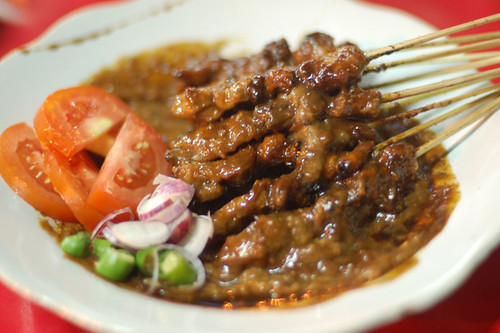Indonesian Food - An Introduction
By Tatie Sri Wulandari

Have you ever tried some tasty Indonesian food? Or maybe ever heard of it? Not like Chinese or Italian food which already well-known all around the world, Indonesian food is probably not so popular.
Indonesian culinary art was influenced by different nations such as Chinese, Arab, Portuguese, Spanish, English and Dutch that came to do the trading on these islands long time ago. The beauty and the richness of spices made the Dutch occupy the country for 350 years. They affectionately called Indonesia gordel van smaragden (The Belt of Emeralds). During their occupation, they planted tomatoes, cabbage, cauliflower, carrots, green beans and lettuce in the highlands where they flourished in near-Dutch weather condition. While the Indians traders brought cucumbers, eggplants and onions in the land, the Spanish and Portuguese brought chilly peppers from America.
It is the Chinese who have had the greatest influence on the food in Indonesia. They introduced noodles, soy sauce, which the Indonesians modified to suit their taste by adding sugar (kecap manis); mung peas used to make bean sprouts; beancurd (tahu) and Soya beans, which the Indonesians learned how to ferment to make the excellent and nutrious Tempe.

The "typical" Indonesian meal is being based on rice, with several savoury side dishes of vegetables, fish, meat or poultry, accompanied by a hot chilly condiment known as sambal, with crackers (krupuk) or fried shallot to provide a crunchy contrast. Probably the most well known of Indonesian dishes are Chicken Satay (Sate Ayam), Fried Rice (Nasi Goreng) and Fried Noodle (Mie Goreng). Eventhough there are many others since the country so big with different kind of ethnic groups.
Eating Indonesian food can be an interesting experience. The diversity of the country will bring you to taste variety of foods. Each of Indonesia's ethnic groups uses the country's entire rich array of the spices, but each has its own combinations and tastes: spicy, sweet, hot and sour. But the real magic in Indonesian cuisine is in the use of aromatic seasonings: fresh red shallots, fresh garlic, fresh rhizomes such as ginger, turmeric, galangal (lengkuas or laos) and other type if galangals such as kencur and temu kunci. There are also fresh leaf seasonings like lemon grass, lemon basil (known as kemangi), kaffir lime, daun salam ( a type of bay leaf), turmeric, Chinese celery and pandan leaf. Although the country is a major producer of spices like nutmeg and cloves, these spices are rarely used in Indonesian's cooking. For sweet taste, they usually add coconut milk, sweet soy sauce or palm/coconut sugar. While the sourness comes from tamarind water, lime juice and sometimes vinegar.
Travelling around Indonesia can prove to be a real challenge for your cuisine curiosity. Indonesia has it all ... from sweet to very spicy food. It is impossible to describe every specialty here since are too many of them. As the world's largest archipelago, Indonesia is a heaven of good food that will awake all of your senses.
Tidak ada komentar:
Posting Komentar